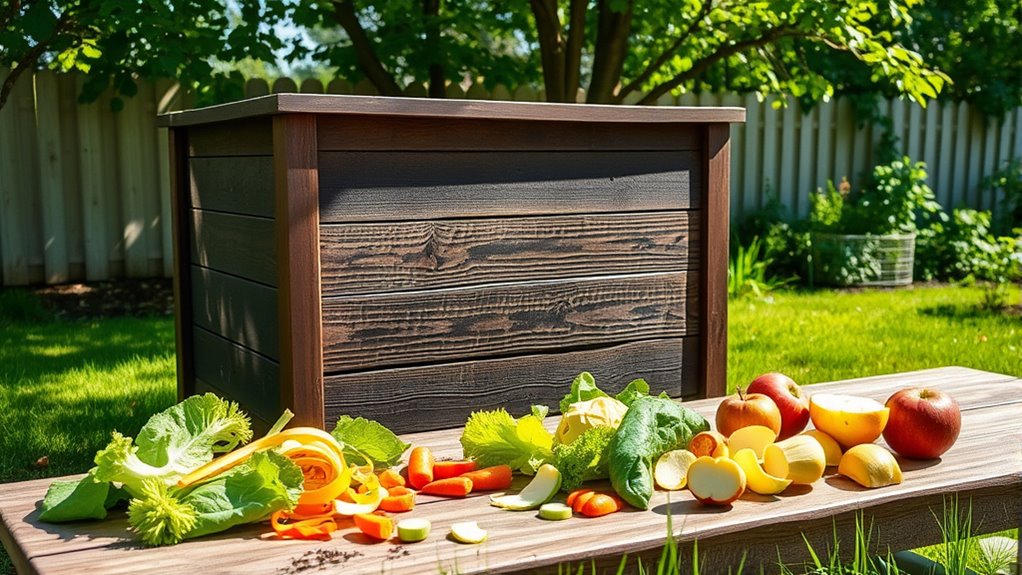Composting is an easy way to cut food waste and help the environment. Start by choosing a simple outdoor bin, tumbler, or indoor system like a worm composter. Layer greens (food scraps) with browns (leaves or paper), keep the pile moist, and turn it regularly. Avoid adding meat or fats. Proper management turns scraps into rich soil, benefiting your garden and the planet. Keep going, and you’ll discover more tips to make composting even simpler.
Key Takeaways
- Choose the right composting system (outdoor bin, tumbler, or indoor setup) based on your space and lifestyle.
- Balance greens (food scraps, grass clippings) and browns (leaves, paper) for efficient decomposition.
- Maintain proper moisture, aerate regularly, and turn the pile to promote microbial activity and prevent odors.
- Avoid composting meats, fats, or oily foods to prevent pests and unpleasant smells.
- Use finished compost to enrich soil, improve plant growth, and further reduce food waste.
Understanding the Benefits of Composting for the Environment

Have you ever wondered how composting benefits the environment? When you compost, you divert organic waste from landfills, reducing methane emissions that power plants produce when waste decomposes anaerobically. This process not only cuts greenhouse gases but also extends landfill lifespans. Compost transforms food scraps and yard waste into nutrient-rich soil, improving soil health naturally and decreasing reliance on chemical fertilizers and pesticides. Additionally, understanding the connection between composting and personal growth and development can motivate individuals to adopt sustainable habits that foster both environmental and personal well-being. Engaging in composting cultivates a sense of responsibility and connection to nature that can enhance overall well-being. Developing an understanding of soil enrichment techniques can further encourage sustainable practices at home. Learning about composting methods can help optimize the process and maximize environmental benefits. Incorporating composting education in communities can increase participation and amplify positive environmental impacts. If everyone in the U.S. composted their food waste, we could prevent nearly 40 million metric tons of CO2 emissions yearly—about 10% of agricultural greenhouse gases. By composting, you help fight climate change, support healthier soils, and promote sustainable waste management—all essential steps toward protecting our planet for future generations.
Getting Started: Choosing the Right Composting Method
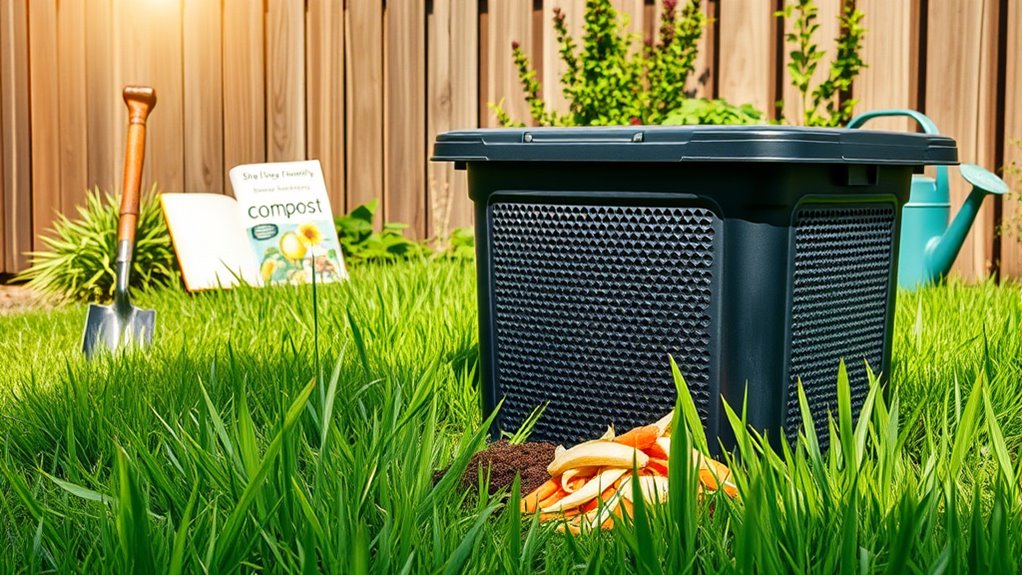
Getting started with composting is simpler than many people think, and choosing the right method depends on your space, lifestyle, and goals. If you have a yard, a traditional compost bin or tumbler works well for outdoor composting, allowing for easy aeration and faster breakdown. If you live in an apartment or have limited space, consider a worm composter or Bokashi system, which are compact and odor-free. For quick results, tumblers provide convenience and minimal effort. If you prefer a low-maintenance option, passive pile composting might suit you. Think about how much time you want to spend, your local climate, and whether you want to produce compost for garden use. Selecting the right method helps ensure your composting journey is successful and sustainable.
What to Compost: Greens, Browns, and Other Materials
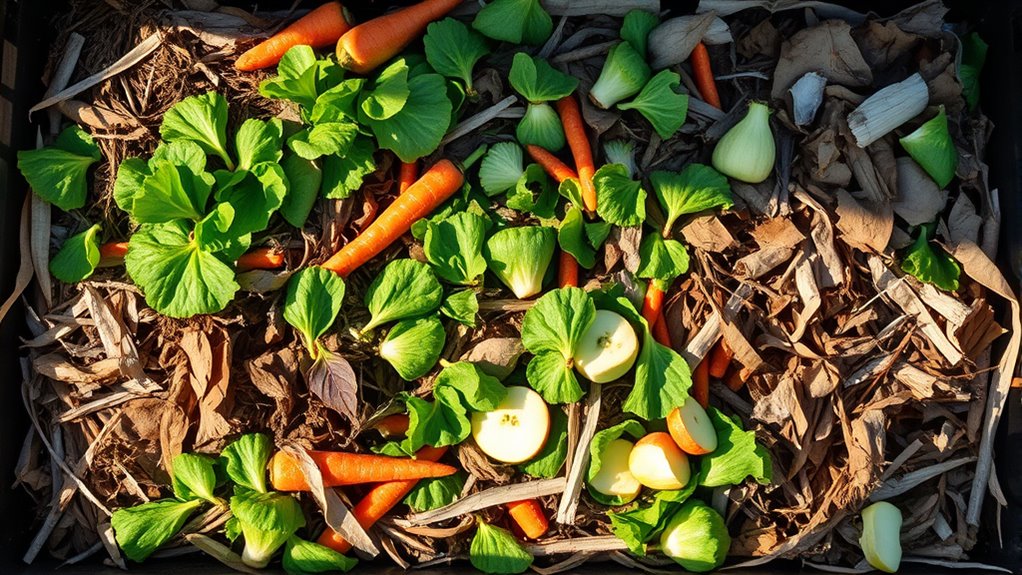
Understanding what to compost is key to successful recycling of organic waste. You should aim to include “greens,” which are nitrogen-rich materials like fruit and vegetable scraps, coffee grounds, and grass clippings. These help fuel microbial activity in your compost. Browns, on the other hand, are carbon-rich materials such as dried leaves, paper, cardboard, straw, and shredded paper. Browns provide structure and prevent odors. You can also add other compostable items like eggshells, coffee filters, and certain food scraps like bones or dairy in small amounts, depending on your setup. Avoid composting meat, fats, oils, and greasy foods, as they attract pests and cause odors. Balance greens and browns to maintain airflow, moisture, and temperature, ensuring efficient decomposition. Proper mammography screening can help detect breast cancer early, which highlights the importance of monitoring your health and understanding your risks. Additionally, understanding local building codes and zoning regulations is essential if you plan to set up a composting system on your property to ensure compliance and avoid potential issues. Maintaining the right water levels also supports microbial activity and speeds up composting. Remember that spoiled lemon juice can attract pests and should be disposed of properly to keep your compost healthy.
Setting Up Your Compost Bin at Home
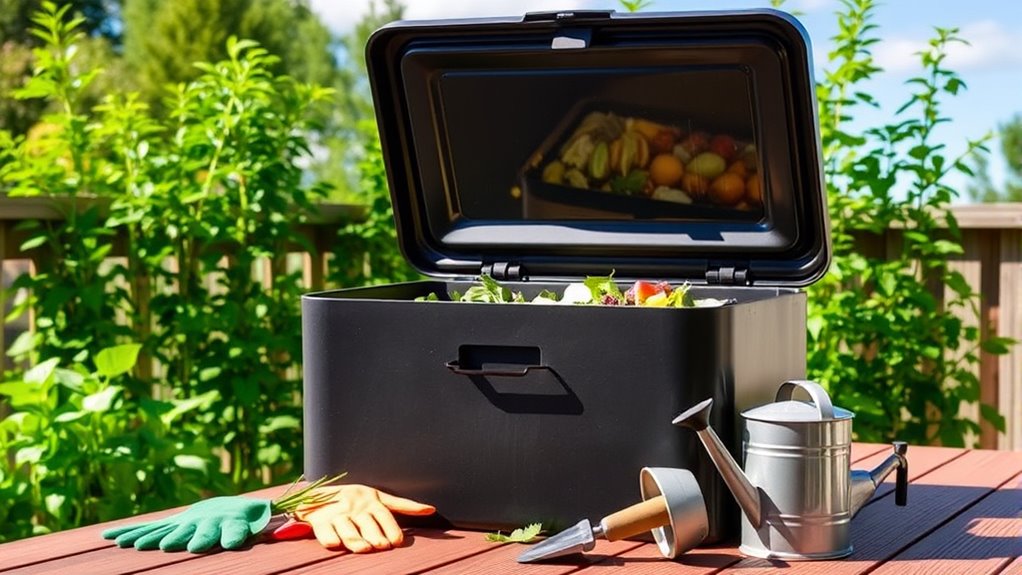
Setting up your compost bin at home is a straightforward process that lays the foundation for successful composting. First, choose a suitable location—ideally a shady, well-drained spot away from your house to minimize odors and pests. Pick a compost bin that fits your space and needs; options include tumblers, traditional bins, or DIY setups. Guarantee your bin has ventilation holes for airflow and a lid to keep out pests. Start by adding a layer of browns like leaves or shredded paper, then a layer of greens such as food scraps or grass clippings. Maintain the right balance, keeping the pile moist but not soggy. Regularly turn or aerate the compost to promote even decomposition and prevent odor buildup.
Managing Your Compost Pile for Healthy Breakdown
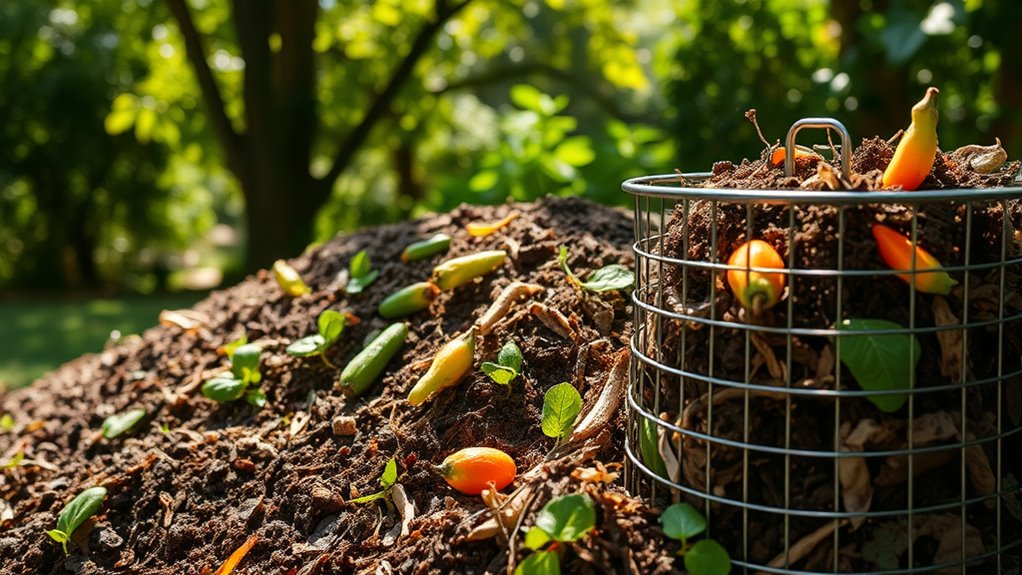
To keep your compost breaking down efficiently, you need to balance greens and browns carefully. Make sure your pile stays moist but not soaked, as proper moisture encourages microbial activity. Regularly check and adjust these elements to prevent odors and guarantee healthy compost development. Incorporating effective moisture control techniques can further optimize the decomposition process. Using suitable compost materials also enhances microbial health and accelerates breakdown. Additionally, understanding industry trends can help you adapt your composting methods to evolving best practices. Staying informed about the latest Vetted – Grobal World innovations in composting can provide new insights and tools to improve your composting success. Considering the Dog names that might inspire your composting journey, such as names reflecting nature or energy, can also add a fun touch to your process.
Balance Greens and Browns
Balancing greens and browns is essential for a healthy compost pile because it guarantees the right mix of nutrients, airflow, and moisture for ideal decomposition. Greens, like fruit and vegetable scraps, provide nitrogen that fuels microbial activity, while browns, such as leaves and paper, supply carbon necessary for energy and structure. Too many greens can cause odors and slow down decomposition, while too many browns can make the pile dry and inactive. Aim for a ratio of about 2 to 3 parts browns to 1 part greens by volume. Mix materials thoroughly to ensure even breakdown and airflow. This balance promotes rapid, odor-free composting and prevents the pile from becoming compacted or soggy, resulting in rich, crumbly compost ready for your garden. Maintaining proper composting conditions is also crucial for successful decomposition, especially considering that agent programs can influence how waste is processed and managed efficiently.
Maintain Proper Moisture
Maintaining the right moisture level is essential for a healthy and efficient composting process. Too much moisture can lead to anaerobic conditions, causing odors and slow decomposition. Too little, and the microbes struggle to break down materials. Aim for a moisture level similar to a damp sponge—moist but not soaked. If your pile feels dry, add water while turning the compost to distribute moisture evenly. Conversely, if it’s too wet, mix in dry materials like leaves or shredded paper to absorb excess moisture. Regularly check your pile’s moisture by squeezing it gently; it should feel damp but not dripping. Proper moisture encourages microbial activity, speeds up composting, and produces rich, crumbly compost in less time. Additionally, monitoring pore size and aeration can further optimize decomposition conditions. Ensuring proper air flow and ventilation can prevent compaction and promote healthy microbial activity. Maintaining optimal moisture also helps sustain the microbial population, which is vital for breaking down organic matter efficiently.
Common Mistakes to Avoid When Composting

Starting your compost pile without paying attention to common mistakes can hinder its efficiency and cause frustration. One mistake is adding too many “greens” like food scraps, which can create odors and slow decomposition. Balance these with “browns” such as leaves or paper to maintain airflow and moisture. Avoid overwatering or letting the pile dry out; your compost needs consistent moisture to break down properly. Another mistake is turning the pile too infrequently, which delays composting; regular aeration speeds up the process. Also, don’t include meat, dairy, or oily foods, as they attract pests and cause odors. Proper compost management techniques, such as maintaining optimal moisture levels and aeration, can significantly improve compost quality. Additionally, understanding composting principles helps in troubleshooting common issues and optimizing decomposing conditions. Maintaining the proper pile size ensures adequate heat retention and microbial activity for effective composting. It’s also important to monitor the carbon-to-nitrogen ratio, as an imbalance can slow down decomposition and produce unpleasant odors. Finally, neglecting proper pile size—too small or too large—can affect heat buildup and decomposition. Incorporating proper techniques like maintaining optimal moisture levels and aeration can significantly improve compost quality. By avoiding these pitfalls, you’ll create rich compost efficiently and with less hassle.
Using Your Compost to Enrich Soil and Support Gardens

Have you ever wondered how compost can transform your garden? When you incorporate compost into your soil, you boost its nutrient content and improve its structure. This natural fertilizer feeds your plants, encouraging healthy growth and vibrant blooms. Compost also increases microbial activity, which helps plants absorb nutrients more efficiently. It enhances soil moisture retention, reducing the need for frequent watering, and prevents erosion by making soil more stable. Applying compost can restore degraded or contaminated soils, turning poor land into productive gardens. Plus, it supports sustainable practices by reducing reliance on chemical fertilizers. Regularly adding compost creates a healthier, more resilient garden environment, helping your plants thrive while supporting ecological balance. It’s a simple way to nurture your garden naturally.
Tips for Expanding Composting in Your Community

Expanding composting efforts in your community can considerably boost environmental benefits and reduce waste. Start by educating neighbors about composting’s advantages through flyers, workshops, or social media. Encourage local officials to support compost programs and seek funding or grants for community compost bins. Collaborate with schools, parks, and businesses to set up composting stations and share best practices. Make composting accessible by providing easy-to-use bins and clear instructions. Promote community challenges or events that motivate participation. Highlight the positive impact on local soil health, waste reduction, and climate change mitigation. Building a network of compost advocates creates momentum, making composting a routine part of community life and expanding its reach and benefits. Additionally, understanding Ulta Beauty Store Hours can help community organizers plan outreach events when stores are open to distribute educational materials.
Frequently Asked Questions
How Long Does It Typically Take for Compost to Be Ready?
It typically takes 3 to 6 months for your compost to be ready, depending on factors like your materials, temperature, moisture, and aeration. If you turn your pile regularly and maintain the right balance of greens and browns, you’ll speed up the process. Keep an eye out for dark, crumbly, earthy-smelling compost. When it looks like rich soil and has no recognizable food scraps, it’s ready to use.
Can I Compost Meat and Dairy Products Safely?
You might think meat and dairy are forbidden guests in your compost, but they can join the party if you’re prepared. While they’re harder to compost and can attract pests, using a hot compost system or an enclosed tumbler can keep things tidy. Just remember, balance your greens and browns, turn the compost regularly, and monitor odors. With patience and care, even these stubborn scraps can transform into rich, nourishing soil.
What Are the Signs of a Compost Pile That’s Not Working?
You’ll know your compost pile isn’t working when it smells sour or rotten, indicating anaerobic decomposition. If it stays overly wet or compacted, airflow is lacking, slowing the process. You might also see no temperature rise, meaning microbial activity is low. Additionally, if scraps remain unbroken down or the pile attracts pests, it’s a sign you need to balance greens and browns or turn it more often.
Is It Necessary to Turn or Aerate the Compost Regularly?
Yes, you should turn or aerate your compost regularly. Doing so introduces oxygen, which speeds up decomposition and prevents unpleasant odors. It also helps mix materials evenly, ensuring all parts break down properly. If you don’t aerate, your compost might become compacted, slowing microbial activity and causing it to smell bad. Aim to turn your pile every few weeks for the best results and healthy, nutrient-rich compost.
How Do I Prevent Pests From Accessing My Compost Bin?
You can prevent pests from accessing your compost bin by securing it with a tight-fitting lid or cover. Avoid adding meat, dairy, or oily foods that attract pests, and bury food scraps deep within the pile. Keep the compost moist but not soggy, and turn it regularly to promote quick decomposition. Using a compost bin with mesh sides or a pest-proof design also helps keep unwanted critters out.
Conclusion
By starting composting today, you’re helping reduce the 30% of food that gets wasted each year. Not only does composting cut down on landfill waste and greenhouse gases, but it also enriches your garden naturally. With simple steps, you can make a big impact on the environment and your community. Remember, every small effort counts—so get composting and turn food scraps into a valuable resource. Your actions truly make a difference!
